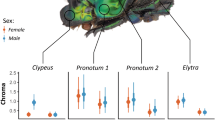Abstract
Recently, 7-methylheptadecane and 7,11-dimethylheptadecane have been reported as sex pheromone components of both spring hemlock looper (SHL), Lambdina athasaria, and pitch pine looper (PPL), Lambdina pellucidaria. Our objective was to test the hypothesis that SHL and PPL are reproductively isolated, in part, through species specificity in: (1) absolute configuration of pheromone components, (2) diel periodicity of pheromonal communication, and/or (3) seasonal flight period. In coupled gas chromatographic–electroantennographic detection (GC-EAD) analyses of stereoselectively synthesized (7S)and (7R)-7-methylheptadecane [7S; 7R] as well as (7S,11S)-, (7R,11R)-, and (meso-7,11)-7,11-dimethylheptadecane [7S,11S; 7R,11R; meso-7,11], only 7S and meso-7,11 elicited responses by male SHL and PPL antennae. In field experiments, male SHL and PPL were attracted only to lures containing 7S plus meso-7,11. In hourly recordings of trap-captured males, SHL and PPL in their respective habitats were trapped between 24:00 and 03:00 hr. Capture of both SHL and PPL in pheromone-baited traps throughout June indicated overlapping seasonal flight periods. These findings of identical absolute configuration of pheromoal components, diel periodicity of pheromonal communication, and overlap of seasonal flight periods support synonymy of SHL and PPL. Finite taxonomic classification of PPL and SHL must await careful assessment of further criteria, such as morphometrics, molecular comparisons and ecological analyses.
Similar content being viewed by others
REFERENCES
Arn, H., Städler, E., and Rauscher, S. 1975. The electroantennographic detector-a selective and sensitive tool in the gas chromatographic analysis of insect pheromones. Z. Naturforsch. 30c:722-725.
Covell, C. V., JR. 1984. A field guide to the moths of eastern North America. Petersen Field Guide Series. Houghton Mifflin, Boston.
Duff, C. M. 1998. Does pheromone biology of spring hemlock looper, Lamdina athasaria, and pitch pine looper, Lambdina pellucidaria (Lepidoptera: Geometridae) contribute to their reproductive isolation? Master's thesis. Simon Fraser University, Burnaby, British Columbia, Canada.
Gries, R., Gries, G., Li, J., Maier, C. T., Lemmon, C. R., and Slessor, K. N. 1994. Sex pheromone components of the spring hemlock looper, Lambdina athasaria (Walker) (Lepidoptera: Geometridae). J. Chem. Ecol. 20:2501-2511.
Haynes, K. F., and Birch, M. C. 1986. Temporal reproductive isolation between two species of plume moths ( Lepidoptera: Pterophoridae). Ann. Entomol. Soc. Am. 79:210-215.
Maier, C. T., and Lemmon, C. R. 1996. Life cycle of Lambdina athasaria (Walker) ( Lepidoptera: Geometridae) developing on hemlock in Connecticut. Can. Entomol. 128:995-1003.
Maier, C. T., Gries, R., and Gries, G. 1998. Sex pheromone components of the pitch pine looper, Lambdina pellucidaria (Grote and Robinson) (Lepidoptera: Geometridae). J. Chem. Ecol. 24:491-500.
Owenby, J. R., and Ezell, D. S. 1992. Monthly station normals of temperature, precipitation, heating and cooling degree days 1961-90 Massachusetts, Connecticut. US Department of Commerce, National Oceanic and Atmospheric Administration National Climactic Center.
Roelofs, W. L., and Brown, R. L. 1982. Pheromone and evolutionary relationships of Tortricidae. Annu. Rev. Ecol. Syst. 12:395-422.
Roelofs, W. L., and Comeau, A. 1969. Sex pheromone specificity: Taxonomic and evolutionary aspects in Lepidoptera. Science 217:657-659.
Sheng, T. 1996. Synthesis of the pheromone components of the milkweed bug, Oncopeltus fasciatus and the spring hemlock looper, Lambdina athasaria. MSc thesis. Simon Fraser University, Burnaby, British Columbia, Canada.
Shirai, Y. 1997. Synthesis of optically active alkanes as insect pheromones and optical resolution of 2,6-dimethylheptane-1,7-diol. MSc thesis. Science University of Tokyo, Tokyo.
Shirai, S., Seki, M., and Mori, K. 1999. Pheromone synthesis, CXCIX: Synthesis of all the stereoisomers of 7-methylheptadecane and 7,11-dimethylheptadecane, the female sex pheromone components of the spring hemlock looper and pitch pine looper. Eur. J. Org. Chem. 1999:3139-3145.
Schweitzer, D. F., and Rawinski, T. J. 1988. Northeastern pitch pine/scrub oak barrens, Eastern Heritage Task Force, The Nature Conservancy, 294 Washington, St., Boston, Massachusetts, 21 pp.
Zhang, B.-C. 1994. Index of economically important Lepidoptera. CAB International, Wallingford, UK.
Zar, J. H. 1984. Biostatistical Analysis, 2nd ed. Prentice-Hall, Englewood Cliffs, New Jersey.
Author information
Authors and Affiliations
Rights and permissions
About this article
Cite this article
Duff, C.M., Gries, G., Mori, K. et al. Does Pheromone Biology of Lambdina athasaria and L. pellucidaria Contribute to Their Reproductive Isolation?. J Chem Ecol 27, 431–442 (2001). https://doi.org/10.1023/A:1010324519127
Issue Date:
DOI: https://doi.org/10.1023/A:1010324519127




